#pigs and cattle in Ireland
Explore tagged Tumblr posts
Text
Food on St Patrick's Day (in the USA)...
...is usually Corned Beef & Cabbage, which is the Irish-American version of the original Irish boiled bacon & cabbage, but while the celebratory Irishness is still going strong, try something a bit more authentic.
A nice warm coddle. Not cuddle, coddle, though just as comforting in its own way. (Some sources suggest it's a hangover cure, not that such a thing would ever be necessary at this time of year, oh dear me no.)
Coddle is a stew using potatoes, onions, bacon, sausages, stout-if-desired / stock-if-not, pepper, sage, thyme and Time.
You'll often see it called "Dublin Coddle", but my Mum made Lisburn Coddle lots of times, I've made West Wicklow Coddle more than once, and on one occasion in a Belgian holiday apartment I made Brugsekoddel, which is an OK spelling for something that doesn't exist in any cookbook.
*****
I do remember one amendment I made to Mum's recipe, which met with slight resistance at the time and great appreciation thereafter.
Her coddle was originally cooked on the stove-top, not in the oven, and nothing was pre-cooked. Potatoes were quartered, onions were sliced, bacon was cut into chunks and then everything went into the big iron casserole, then onto the slow back ring, and there it simmered Until Done.
However, the bacon was thick-cut back rashers, and the sausages were pork chipolatas.
Raw, they looked like this:
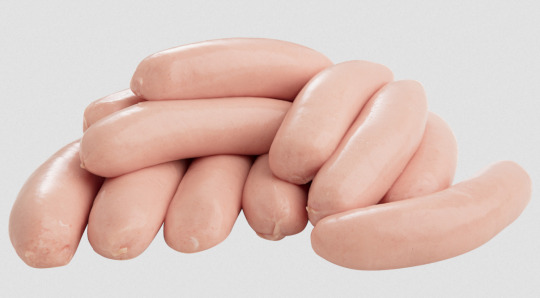
...and the bacon looked like this:

Cooked in the way Mum initially did, they looked pretty much the same afterwards. The sausages didn't change colour. Nor did the bacon.
While everything tasted fine, the meat parts always looked - to me, anyway - somewhat ... less than appealing. "Surgical appliance pink" is the kindest way to put it, and that's all I'm saying. This is apparently "white coddle" and Dubs can get quite defensive about This Is The Way It SHOULD Look.
I'm not a Dub, so I persuaded Mum to fry both the bacon and sausages first, just enough to get a bit of brown on, and wow! Improvement! I remember my Dad nodding in approval but - because he was Wise - not saying anything aloud until Mum gave it the green light as well.
Doing the coddle in the oven, first with lid on then with lid off, came later and met with equal approval. So did using only half of the onion raw and frying the other half lightly golden in the bacon fat.
Nobody quoted from a movie that wouldn't be made for another decade, but there was a definite feeling of...

*****
There are coddle recipes all over the Net: I've made sure that these are from Ireland to avoid the corned-beef-not-boiled-bacon "adjustment" versions which are definitely out there. I've already seen one with Bratwurst. Just wait, it'll be chorizo next.
Oh, hell's teeth, I was right. And from RTE...
Returning to relative normality, here's Donal Skehan's white coddle and his browned coddle with barley (I'm going to try that one).
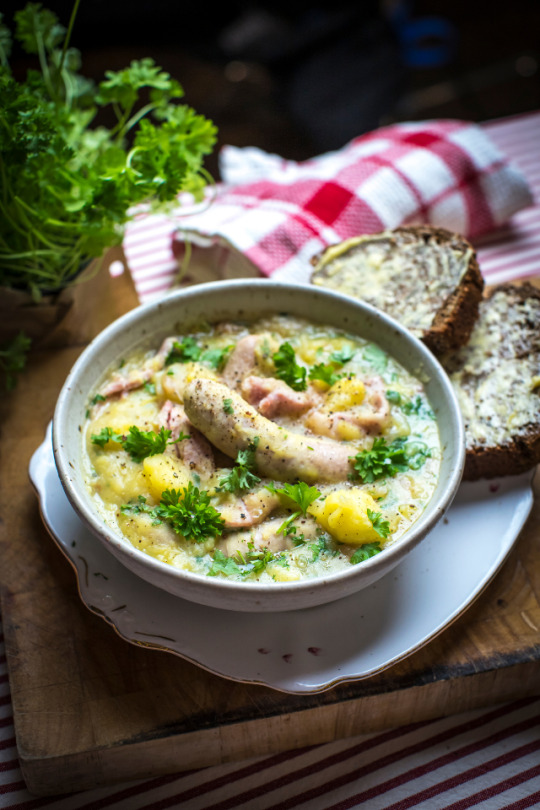
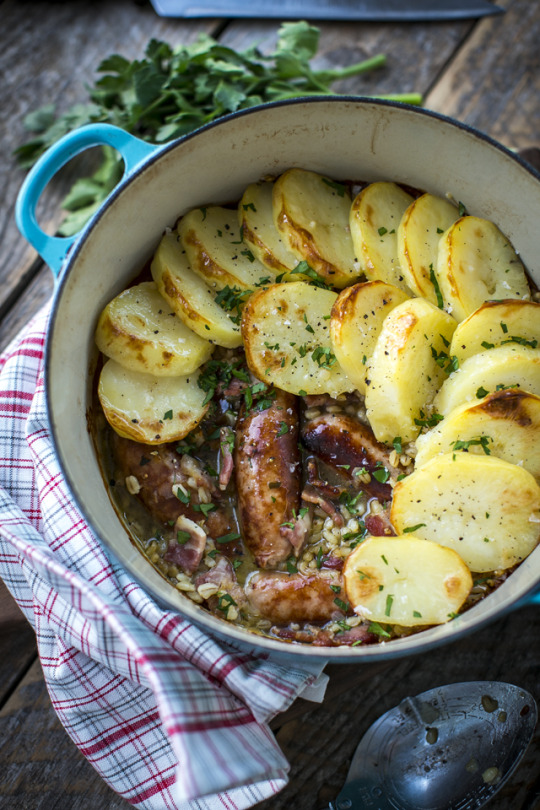
Here's Dairina Allen's Frenchified with US measurements version. (I feel considerably less heretical now.)
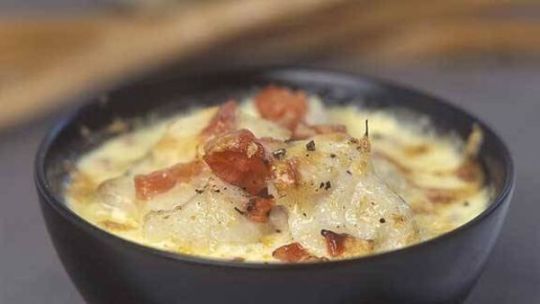
And finally (OK, not Irish, but it references a couple of the previous ones and is a VERY comprehensive write-up, so gets a pass) Felicity Cloake's Perfect Dublin Coddle (perfect according to who, exactly...?) in The Guardian.
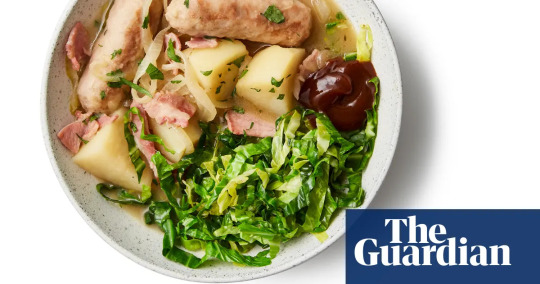
*****
Returning to the beginning, and how boiled bacon became corned beef (a question which prompted @dduane to start an entire website...!)
The traditional Irish meat animal for those who could afford it was the pig, but when Irish immigrants (even before the Great Famine) arrived in the USA, they often lived in the same urban districts as Jewish immigrants from Eastern Europe.
For fairly obvious reasons pork, bacon and other piggy products were unavailable in those districts, but salt beef was right there and far cheaper than any meat Irish immigrants had ever seen before.
Insist on tradition or eat what was easy to find? There'd have been contest - and do I sometimes wonder a bit if sauerkraut ever came close to replacing cabbage for the same reason.
The pre-Famine Irish palate liked sour tastes: a German (?) visitor to Ireland in the mid-1600s wrote about about what were called "the best-favoured peasantry in Europe", and mentioned that they had "seventy-several sour milks and creams*, and the sourer they be, the better they like them."
* Yogurt? Kefir? Skyr? Gosh...
Corned beef and Kraut as the immigrants' celebratory "Irish" meal for St Patrick's Day? Maybe, maybe not.
Time for "Immigrant Song" (with kittens).
youtube
*****
Corned beef got its name from the size of the salt grains with which the beef was prepared. They were usually bigger than kosher salt, like pinhead oats or even as large as grains of wheat, and their name derived originally from "corned (gun)powder", the large coarse grains used in cannon.
BTW, "corn" has been a generic English term for "grain" for centuries, and "but Europe didn't have corn" is an American mistake assuming the word refers to sweetcorn / maize, which it doesn't.
Lindsey Davis, author of the "Falco" series, had a couple of rants about it and other US-requested "corrections". As she points out, mistakes need corrected but "corn" is not a mistake, just a difference in vocabulary.
*****
In Ancient and Medieval Ireland pig would have included wild boar, the hunting of which was a suitable pastime for warriors and heroes, because Mr Boar took a very dim view of the whole proceeding and wasn't shy about showing it (see "wild boar" in my tags and learn more).
Cattle were for milk, butter, cream and little cattle; also wealth, status, and heroic displays in their theft, defence or recovery. It's no accident that THE great Irish epic is "The Cattle-Raid of Cooley" / Táin Bó Cúailnge (tawn / toyn boh cool-nyah).
Killing a cow for meat was ostentation on a level of lighting cigars with 100-, or even 500-, currency-unit notes. Once it had been cooked and eaten there'd be no more milk, butter, cream or little cattle from that source, so eating beef was showing off And Then Some.
Also, loaning a prize bull to run with someone else's heifers was a sign of great friendship or alliance, while refusing it might be an excuse for enmity or even war. IMO that's what Maeve of Connaught intended all along, picking undiplomatic envoys who would get drunk and shoot their mouths off so the loan was refused and she, insulted, would have an excuse to...
But I digress, as usual. Or again. Or still... :->
*****
For the most part, "pig" mean "domestic porker", and in later periods right up to the Famine, these animals were seldom eaten.
Instead, known as "the gentleman who pays the rent", the family pig ate kitchen scraps and rooted about for other foods, none of which the tenant had to grow or buy for them. These fattened pigs would go to market twice a year, and the money from their sale would literally pay that half-year's rent.
For wealthier (less poor?) farmers, pigs had another advantage. Calves arrived singly, lambs might be a pair, but piglets popped out by the dozen. A sow with (some of) her farrow was even commemorated on the old ha'penny coin...

What with bulls, chickens, hares, horses, hounds, pigs, salmon and stags, the pre-decimal Irish coinage is a good inspiration for some sort of fantasy currency.
But that's another post, for another day.
#food and drink#St Patrick's Day#Irish cuisine#Dublin coddle#corned beef or boiled bacon#pigs and cattle in Ireland#The Cattle Raid of Cooley#Youtube
598 notes
·
View notes
Text

Bridget - Bright Goddess of the Gael Talon Abraxas
Brigid was a goddess of the Tuatha Dé Danann. She was a daughter of the chief of the gods, The Dagda, and was known as a goddess of healers, poets, smiths, childbirth and inspiration. Her name means “exalted one”. This article by Branfionn NicGrioghair explores the story of Brigid and the later Christian Saint, St. Brigid, who is still honoured to this day, especially in Faughart, her birthplace, and Kildare, where she founded a monastery.
Brigid is the Daughter of the Dagda, one of the more universal deities of the pagan Gaelic world. She is known as the Goddess of Healers, Poets, Smiths, Childbirth and Inspiration; Goddess of Fire and Hearth and a patron of warfare or Briga. Her soldiers were called Brigands. Her name means “Exalted One.” She is also known as Brigantia, Brid, Bride, Briginda, Brigdu, and Brigit. She is said to lean over every cradle. The lore and customs have continued to this day regarding Brighid, more vividly than all the other Gaelic deities combined.
In the middle ages, Brigid is in many stories. In one she is the wife of Bres, the half-Fomorian ruler of the Tuatha Dé Danann. Their son, Ruadan, wounded the smith god Giobhniu at the second battle of Magh Tuireadh but he himself was slain in the combat. Brigid then went to the battlefield to mourn her son. This was said to be the first caoine (keening), or lament, heard in Ireland. Until recent time, it was a tradition to hire women to caoine at every graveside. In another story, Brighid was the wife of Tuireann and had three sons: Brian, Iuchar and Ircharba. In the tale, The Sons of Tuirean, these three killed the god Cian, father of Lugh Lámhfhada when he was in the form of a pig.
She was transformed by the Church of St. Brigid into St. Brigid about 453 C.E. Saint Brighid is known as the patroness of farm work and cattle, and protector of the household from fire and calamity. To this day, one of her most common names in Gaelic is Muime Chriosd, “Foster-Mother of Christ.” St. Brigid was said to be the daughter of Dubthach, a Druid who brought her from Ireland to be raised on the Isle of Iona, sometimes called “The Druid’s Isle.”
39 notes
·
View notes
Text
Authentic Irish Foods for Samhain
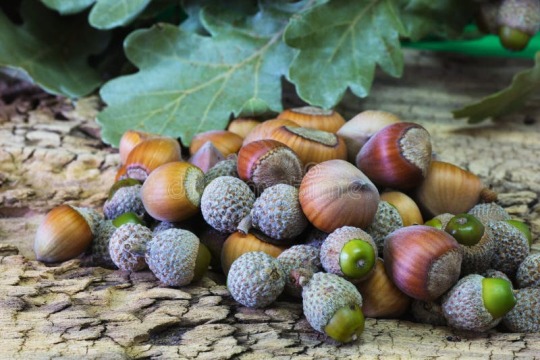
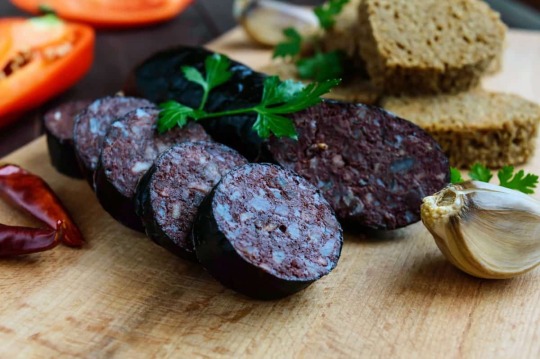


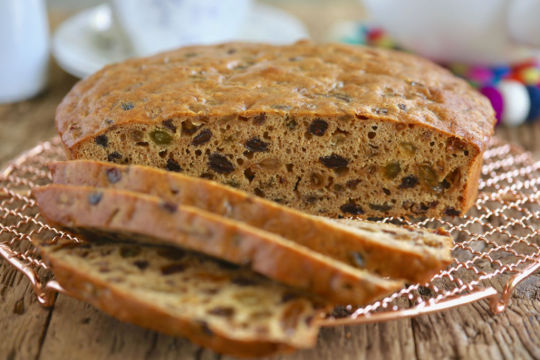
🩸 Blood pudding (living cattle could be bled through the winter to provide the material as well as collecting blood when the cattle were slaughtered to keep the numbers down for winter)
🫓 Brambrack
🍲 Stew
Lamb
Beef
Wild boar
Domestic pig
Deer
Goose
Mallard
Hare
🐗 Salted wild boar and domestic pig (it is possible that other meats were salted for preservation but given that salt was an expensive commodity and no records indicate other meats we simply do not know. I will note here that we also don't seem to have records of smoked meats for preservation during this time)
🦌 From Samhain to Bealtaine it was considered inappropriate to hunt wild game, including boar. So while wild meats were likely eaten and preserved through this time, much like crop harvests for Lughnasadh, any game that wasn't taken before this festival was supposed to be left alone to breed. (Very unlike our modern hunting schedules)
🍺 Mead and Barely ale
🥣 Porridge
Oat
Barley
🥛 Dairy (this would likely become more limited as the season progressed, but butter has been found in bogs, presumed to be preserved but potentially given as offerings)
Cow's milk
Butter
Curds
mulchán 'hard cheese' (the exact nature of this cheese is unknown but it was described as being extremely hard and could be stored for long periods of time)
🦪 Sea food
Sloke
Clams
Muscles
Crab
Halibut
Sea Salmon
🌿Native Culinary Plants growing in Ireland at this time of year
Skirret
Apples
Purple sprouting boccoli
Wild cabbage
Blackberry
Raspberry
Rowan berries
Elder berries
Sloes
Rosehip
Acorn
Chestnuts
Hazelnuts
Hen of the woods
Pullball
Fairy Ring Champignon
Chanterelle
Porcini
Black Trumpet
Saffron Milk Caps
Cauliflower Mushroom
Wood Blewit
Penny bun
There would be an abundance of foods at this point in the year, but that food would become lesser as the season progressed do to lack of production in the environment and the fact that this point in the year was a time for traveling and feasting (likely to increase bonds amongs the Tuatha and because people would not be as occupied with farming and raiding).
My Kofi
#irish#irish mythology#celtic#irish paganism#irish polytheism#paganism#celtic paganism#celtic polytheism#pagan#food#iron age#samhain#wild boar#deer#porridge#Brambrack#mead#apples#blackberry#elderberry#acorn#chestnut#hazelnut#mushrooms#blood pudding#irish reconstructionist#Irish reconstructionism
203 notes
·
View notes
Text
From the blog of K. J. Charles dated 19th April 2024, copy-pasted for Tumblr history nerds and historical fiction writers.
----------------------------------------------
Eponymosity!
A quickie blog post today, inspired by Benjamin Dreyer’s entertaining rant on the distinction between eponymous and titular (it’s in footnote 1 for a clearer explanation than I am inclined/able to provide), and also by the fact that one of these sneaky little bastards nearly got me in a recent book.
So. An eponym is simply a word taken from a person’s name. Obamacare is an eponym, so is Reaganomics. If you hoover your carpets, the verb comes from the eponymous brand of vacuum cleaner. (We do not use the capital letter, no matter what the Hoover corporation may think: that ship has sailed, as demonstrated by the fact that I hoover with a Dyson.)
If you write historical novels, eponyms are one of those damn things. They tend to be extremely and usefully specific in meaning, but they are also extremely specific in dates, meaning you can’t rely on the old “well it was probably around for decades before it made it into the dictionary” line.
Here for your advisory is an incomplete list of eponyms that may trip you up, depending on period.
Boycott: The name comes from 1880 (Ireland, Charles Boycott, a shitty land agent who was socially and economically ostracised). The practice is older: there was a widespread boycott in the UK of slavery-produced sugar starting in 1791, during which sales plummeted by something like 40%. It is totally historically plausible to have a consumer or personal boycott in your Georgian or Regency novel, but you can’t call it a boycott for several decades more.
Chauvinist: Named for a French vaudeville character. Meaning ‘blinkered nationalist’ it dates from 1840; you can’t use it for a male pig until 1960.
Fedora: The hat beloved of men who spend too long on the internet getting angry about Star Wars sequels actually used to be a symbol of female liberation and cross dressing. Comes from the 1887 play Fédora starring Sarah Bernhardt.
Fuchsia: You will be able to spell this if you remember it’s an eponym for Mr Fuchs. The flowers are so named in the UK in the 1750s, the colour not till the 1920s. Do not put your Regency heroine in fuchsia, is what I mean.
Maverick: Supposedly from a US cattle owner, Samuel Maverick, who let his calves run wild. 1880s US at the very earliest, more probably 1930s. Yes, that is irritating.
Mesmeric: He may have compelling eyes but they ain’t mesmeric before the 1860s. The hypnotist Mesmer flourished in the late 1700s, giving us mesmerism (hypnosis); mesmerise wasn’t a verb till the end of the Regency, and even then it still meant ‘to put into a hypnotic trance’.
Sadistic: Marquis de Sade, as you already know, but NB that sadist/sadistic aren’t in general use till the 1890s or so when sexology got going, along with masochism (also an eponym).
Sandwich: 1762 since you ask.
Silhouette: The outline picture is named for French finance minister Etienne de Silhouette. Used in France from 1760. However, despite there being a craze for silhouettes in England, the actual word didn’t come here till the mid 1820s, which is sodding annoying if your novel about a silhouette cutter happens to be set in 1819 I’M JUST SAYING.
Sweet Fanny Adams: This UK usage originally referring to something no good, now often used as an alternative to ‘sweet FA/fuck all’, came in from 1869 and cannot be used before 1867. You really don’t want to know where it comes from but here if you must (be warned, it’s genuinely grim). (My note: tw for CSA and child murder.)
Thug: Originally from India. Used to describe the Thuggee (as Brits then called it) sect from 1810. Didn’t become generalised to all violent lowlifes till 1839. You can’t be assaulted by thugs in a Regency unless they are actually Thugs.
Trilby: Another hat your Regency gentleman can’t wear. Comes from George du Maurier’s mega hit Trilby published 1894, which also gave us svengali (the name of the baddie in the book).
Feel free to add to this in the comments, there’s always something!
Death in the Spires, my Oxford-set historical murder mystery, is out now. The silhouette book, The Duke at Hazard, publishes in July.
----------------------------------------------
End c+p.
KJ Charles is one of my absolute favourite writers in the world and the contemporary star in the crown of the MM historical romance genre. Her blog is also worthy of following because she reads incredibly widely and diversely and posts book recommendations as well as good advice about writing.
Re: Dreyer's rant, I am absolutely a prescriptivist, and if you use the word "nonplussed" in that unholy way I'm blocking you. We colonized folk of the former Raj didn't learn the intricacies of this cussed language for you to change meanings on a dime because you couldn't be bothered to crack open a dictionary.
#I have a vague suspicion this has something to with USAmericans trying to write#a phenomenon that should be discouraged and avoided at all costs. /jk#languages#history#english vocabulary#kj charles#writing advice#british history#regency romance#cool history facts#linguistics#historical fiction#knee of huss
21 notes
·
View notes
Text
Cudgel War 2025 Laurel Prize Display: No Summer In Ireland (A Crown of Triads)
This was my entry for the Laurel Prize Display at Cudgel War 2025 in the Barony of Aarnimetsä in Drachenwald.
The triad is a medieval Irish poetic form, with some resemblance to the Japanese haiku. It does not have a defined meter or number of syllables, but has some broad characteristics that can be reproduced.
Triads are mostly known from a (probably) ninth-century work called Trecheng Breth Féne, translated as "A Triad of Judgments of the Irish", which contains 256 of them (not all strictly triads). There are also Welsh triads, and the form appears in later Irish law texts, possibly as an aid to memory.
The only existing translation of the Trecheng Breth Féne was by Kuno Meyer, in 1906. It includes material from six of the nine manuscripts known at the time, and three more have since been discovered. The other manuscripts might contain more triads. Additionally, Meyer’s translations frequently take more poetic license than a modern one would, so further examination of these would be useful.
The form is: Three [description of a category]: example 1, example 2, example 3.
The examples are sometimes direct; three things which match the description. Occasional triads have the third example as a twist - something that matches the description only in metaphorical terms, or which jars against the previous two in tone.
Many of the existing triads are simple collections of notable places:
[49] The three highroads of Ireland: Slige Dala, Slige Asail, Slige Luachra.
[50] The three mountain-passes of Ireland: Baltinglass, the Pass of Limerick, the Pass of Dublin.
More are advice or proverbs:
[64] Three unfortunate things for a man: a scant drink of water, thirst in an ale-house, a narrow seat upon a field.
Some enforce social strictures and rules:
[71] Three unfortunate things for the son of a peasant: marrying into the family of a franklin, attaching himself to the retinue of a king, consorting with thieves.
There is a particular feature in this written form, where consecutive triads reverse one another:
[72] Three unfortunate things for a householder: proposing to a bad woman, serving a bad chief, exchanging for bad land.
[73] Three excellent things for a householder: proposing to a good woman, serving a good chief, exchanging for good land.
Explanation
For the triads I’ve written here, I’ve arranged them in three sets: winter, spring, and autumn, the joke being that Ireland has no summer. I’ve written them from the point of view of early medieval Ireland, using only the species of plants and animals I know to have been present (before the Norman introduction of ducks or pigeons, for example). I’ve also given a lot of weight to the importance of cattle, pigs, and grain, which were vital concerns both in myth and in law at that time. I’ve used the twist in the third example, sparingly; the reversal in consecutive triads; and a nod to the collections of places, although I’ve left them in the abstract rather than using place names which will be meaningless to most non-Irish readers. Seasonal concerns come through naturally from the three sets (each with three subsets of three triads), and I like the way this echoes the haiku.
Battle and warfare are mentioned only in the autumn set; there is a lot of evidence in early medieval texts from across Europe that battles were only fought in the gap between the harvest and the difficulty of travel in winter. Many conflicts in Ireland were over cattle, too, and the autumn is a good time to move them, whether moving yours to a winter pasture, or moving your neighbours' cattle to somewhere else.
The “Crown of Triads” references a meta-form in much later English poetry called a “Crown of Sonnets”, something which, despite sonnets being my main form, I have not yet succeeded in writing.
Winter
1.1 Three colours of winter: the black of night, the grey of the sky, the white of frost.
1.2 Three scents of winter: the smoke of peat, the sharpness of snow, the pine bough.
1.3 Three tastes of winter: the roundness of porridge, the salt of meat, the pang of hunger.
2.1 Three feelings of winter: being lost in the night, being cold, finding the firelight in the valley
2.2 Three fears of winter: the cattle lost, the food not enough, the coming of the snow.
2.3 Three hopes of winter: the warmth of the bed, the turning at the solstice, the coming of spring
3.1 Three birds of winter: the shrieking gull, the clucking hen, the bright robin.
3.2 Three beasts of winter: the cow in calf, the sow in pig, the fox in thieving.
3.3 Three places of winter: the fireside, the cliffside, the grave.
Spring
1.1 Three colours of spring: the green of the new leaf, the yellow of the celandine, the blue of the clear sky.
1.2 Three scents of spring: the milk for the calf, the garlic in the woods, the bitter last of the ale.
1.3 Three tastes of spring: the first of the greens, the new eggs, the fresh leek.
2.1 Three feelings of spring: the relief of eating, the worry of calving, the rise in the blood.
2.2 Three fears of spring: that the calf will die, that the cow will die, that the corn will not grow.
2.3 Three hopes of spring: that the calf will live, that the cow will live, that the corn will sprout.
3.1 Three birds of spring: the corncrake in the field, the gannet on the rock, the swallow in the sky.
3.2 Three beasts of spring: the calf by its mother, the piglet by the sow, the hare in the meadow.
3.3 Three places of spring: the river bank, the sea shore, the top of the hill.
Autumn
1.1 Three colours of autumn: the red of the berry, the gold of the leaf, the grey of the sky.
1.2 Three scents of autumn: the smoke of the fire, the mushrooms in the woods, the blood of the slaughter.
1.3 Three tastes of autumn: the sweetness of honey, the sourness of the sloe, the fresh-made bread.
2.1 Three feelings of autumn: the fullness of the belly, the comfort of the harvest, the dreams of the dead.
2.2 Three fears of autumn: the storm before the harvest, the boat lost at sea, the son lost in battle.
2.3 Three hopes of autumn: the grain store filled full, the salmon to smoke, the warriors victorious
3.1 Three birds of autumn: the goose in the bog, the swallows gathering, the crow among the dead.
3.2 Three beasts of autumn: the fatted boar, the climbing squirrel, the barn cat.
3.3 Three places of autumn: the wheat field, the peat bog, the battlefield.
References:
The Triads of Ireland, CELT Edition: https://celt.ucc.ie/published/T103006/
#sca#cudgel war#laurel prize display#poetry#irish poetry#medieval poetry#barony of aarnimetsä#drachenwald#irish triads#triads
9 notes
·
View notes
Note
Thinking about ghouls as farmers/farmhands
I imagine that some types of kagune would be excellent for harvesting/ploughing with a nice bonus of no carbon emissions. I imagine ghouls, after criminalisation, would possibly even revolutionise farming/carbon footprint from farming?
(Although of course ideally a farm wouldnt till but even then for harvesting ghouls would be quite efficient.)
GHOULS IN FARMING AND FOOD PRODUCTION IS SO INTERESTING
Ghouls have always been a part of society, and regardless of where they are or how accepted they are, they’ve always had some hand in farming since, especially before industrialization, it was a good field for them. Their strength, senses, and kagune make them fantastic at cultivating, protecting, and harvesting food
In old world cultures where ghouls were always ostracized, they couldn’t be open about why their crops grew so well, so they tended to make up myths and stories about some ritual or another that makes their harvests so bountiful. They had senses of smell and pressure detection that could help them sniff out blights and pests, as well as semi-accurately predict rainfall, letting them handle issues before they got too bad. That, and their strength that lets them handle the physical task of planting and harvesting, helped them produce a lot of plants. But telling humans how they did it is off the table, so it was common for them to have a plowing Ox just for show and to say they said some prayer that helped
A lot of why ghouls thrived in farming is due to their regeneration. It may not be talked about much anymore, but it is DANGEROUS. Not just the modern machinery, but the strain of lifting and carrying. The illnesses carried by plants and animals. The workhorses and oxen that can just fucking kick you to death. The PIGS. It’s all risky work, and back before antibiotics, just one cut and you’re done for. A person who can not only survive almost any cut, but take a donkey kick to the face and get right back up to finish plowing the field is one of the most valuable people any farming village can have
Farming animals is more hit or Miss, because a lot of prey animals panic when they smell ghoul. Some ghouls still kept them and after enough time, or enough animals born around the smell of them, they could get used to it. Historically ghouls have run a lot of butcher shops because it was one of the best places to hide human meat before dna testing became widely available, so some animal husbandry skill was a good thing
Ghouls tended to make good shepherds. In especially rural areas, a lot of humans would collectively decide not to talk about the fact that someone is obviously a monster because they’re simply so fast and strong and don’t let sheep and cattle go missing or get hunted. If you were in Cold Ass Nowhere Ireland in 1635 and you had a shepherd who not only never loses a sheep but also eats the English, you’d pretend you didn’t notice either
In areas and cultures where ghouls were more accepted, they were essential to hunting and farming. North and central american ghouls had traits designed for taking down megafauna to supplement their diets, and their human companions could depend on them to bring countless Buffalo and deer home. Jungle subspecies had traits built for climbing, and were central to the harvest of high growing fruits and beans. A now likely extinct species native to Canada had semi aquatic adaptations and a thick layer of fat who were designed to hunt seals and small whales, and shaped the way any community lucky enough to have some survived. In places where ghouls were welcomed, they were so efficient at harvesting and hunting that land rarely needed to be developed for monocultures at all
When ghouls are decriminalized in more parts of the world, their physical abilities are allowed to shine again. Stories of ghoul farmers through history arise. Plenty of American and Polynesian communities (who had been telling people about ghoul’s contributions to their land and cultures for years and were having that brushed off as myth) can legally reintroduce the old practices of ghoul hunting and harvesting techniques. Smaller farms hire more ghouls once it’s clear that they can do machine level work without the expense of maintaining machines, and it’s one of the biggest ghoul hiring fields at the start of their legalization
Naturally, ghoul farming unions are quick to form. They can do machine level work, but are not going to risk being treated like machines for it. As with any Union there’s some backlash, but when it becomes apparent just how much better ghouls are at crop maintenance and harvesting, demands are met. It’s become a well paying profession, and has been good work for ghouls that struggle with the human grade education they were denied when they were younger, or ghouls who simply prefer to work outside doing something that benefits people
41 notes
·
View notes
Text
NED KELLY
NED KELLY
December 1854 – 11 November 1880
Kelly’s father John ‘Red’ was born in Ireland who stole pigs and was transported to Van Diemen’s Land, Australia in 1841 as a convict. After his release he moved to Victoria and became lucky due to gold-digging and purchased a home and married Ellen in Ballarat. Kelly grew up in the bush and once saved a boy from drowning and was given a green sash by the boy’s family which he wore under his armour during the final showdown. Red stole cattle and died during his time of hard labour, which left Ellen alone with eight children. The Kelly family were also known for theft which led to Kelly’s bushranger lifestyle and led Australia’s most famous gang. After a series of offences, the police declared them wanted outlaws.
The Siege at Glenrowan started on 27 June 1880, when the gang gathered inside a hotel with 62 hostages from the town. The gang treated the hostages well, providing them with drinks, music and entertainment. Kelly and his gang had bullet-repelling armour and helmets which weighed 44 kilos, but their legs remained exposed. Over the armour they wore grey coats. At 10pm, Kelly and some of his gang left to capture the local Constable and took him back to the hotel. Two trains from Melbourne carrying police and reporters were stopped by a local who told them about the Kelly Gang at the hotel. Some of the hostages were released except for the Constable who was able to escape and warn police.
Police and Aboriginal trackers arrived at the hotel, where the police and gang fired at one another for an hour. The authorities then surrounded the hotel during the night, at 5am the next morning, and fire continued until more police arrived at the scene. The rest of the hostages were released. Kelly then approached the police wearing his iron armour, mask and overcoat, he fired at the police and hid behind trees during the attack. The Sergeant shot Kelly twice in the legs and feet, Kelly screamed out ‘I am done – I am done’. Kelly was carried away and his wounds were dressed, whilst his gang continued firing at the police from the hotel until it later ceased when fire was set to the hotel.
Kelly stood trial and was charged with murder, bank robberies as well as other crimes. He was sentenced to hanging and was permitted to farewell his family members. Kelly was hanged on 11 November 1880 at Old Melbourne Gaol. On his way to his execution, he walked past flower beds which he remarked, ‘what a nice little garden’. Some say his last words was ‘Such is life’ or ‘Ah, well, I suppose it has come to this,’.

#nedkelly
4 notes
·
View notes
Text
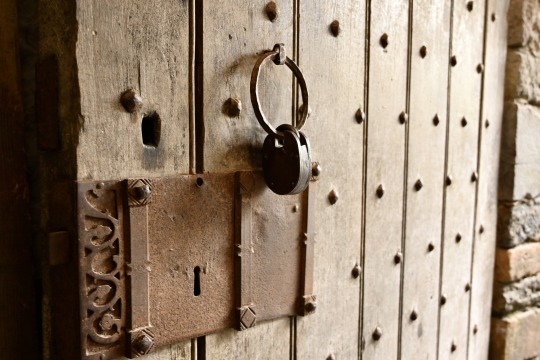
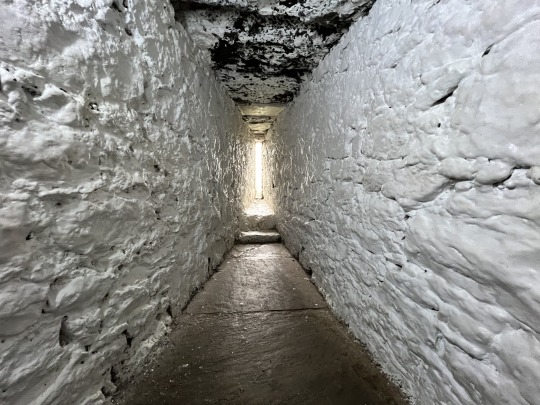
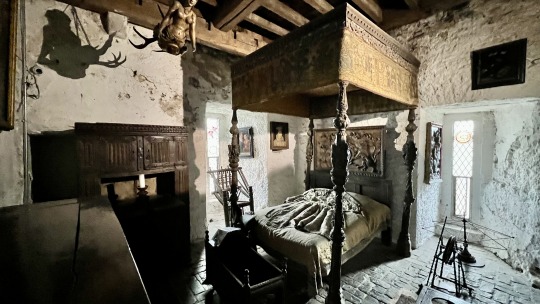
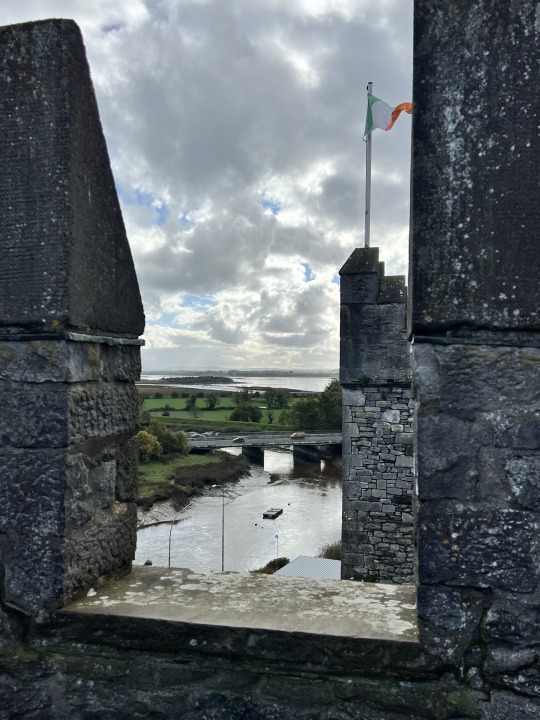
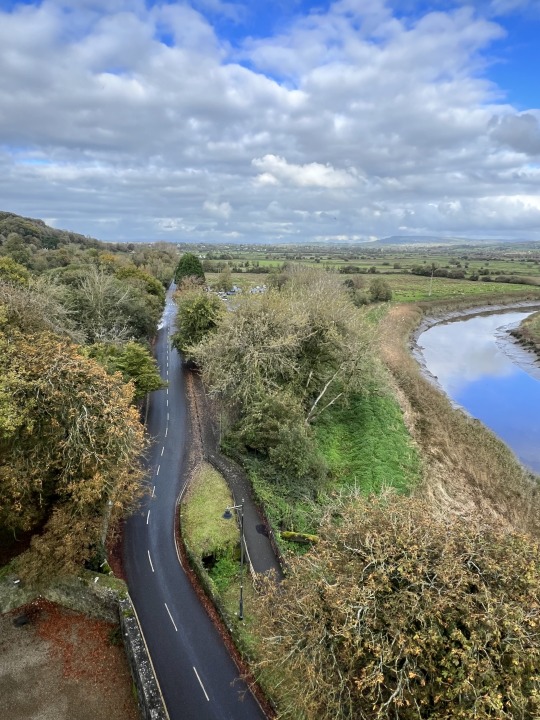
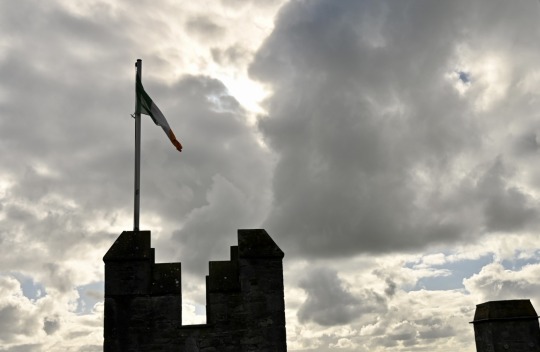
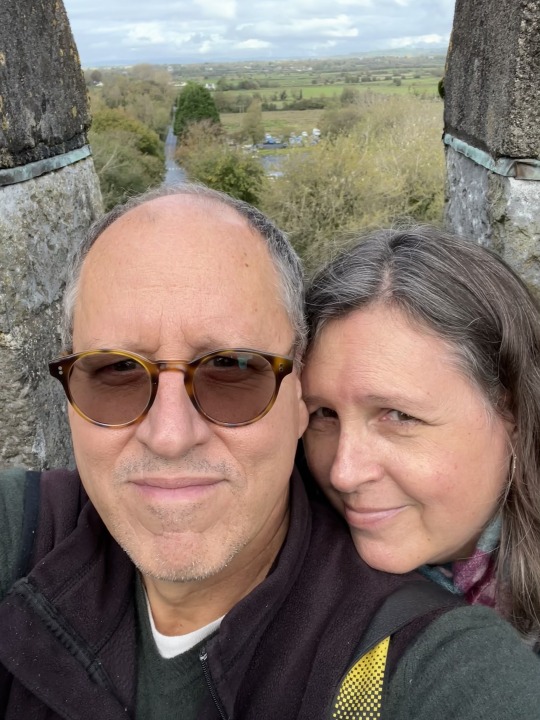
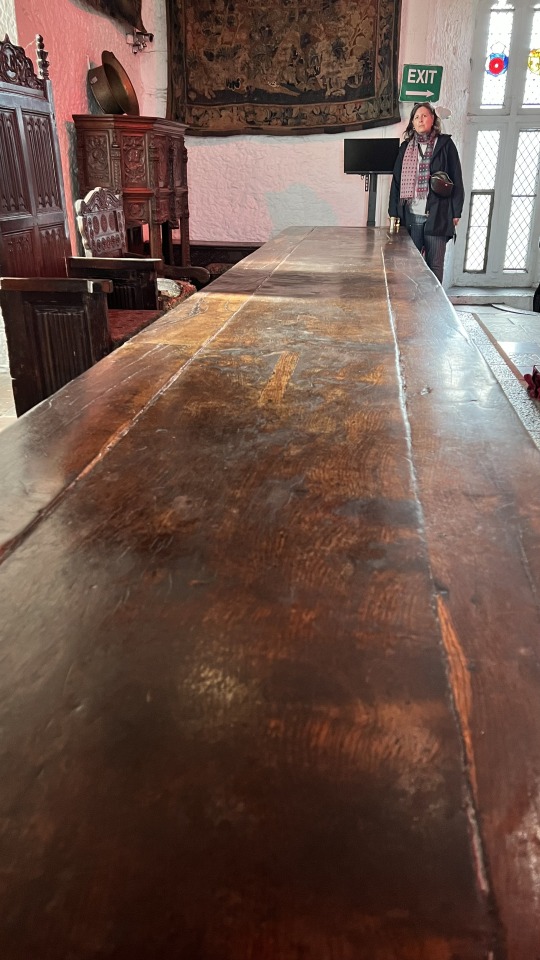
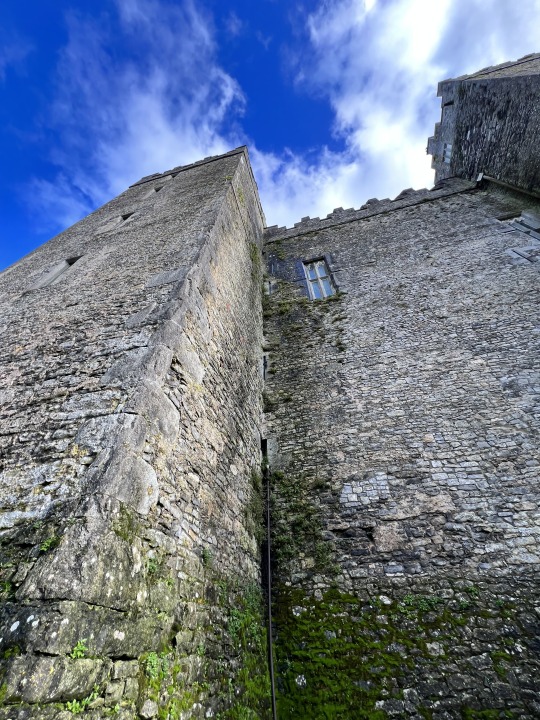
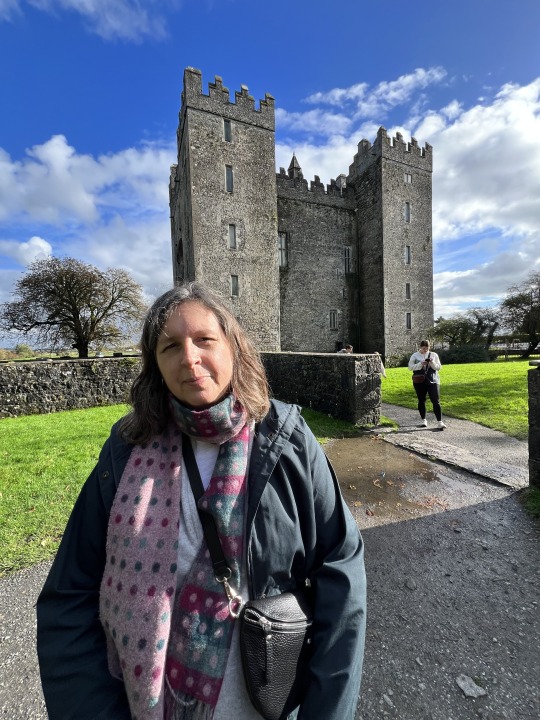
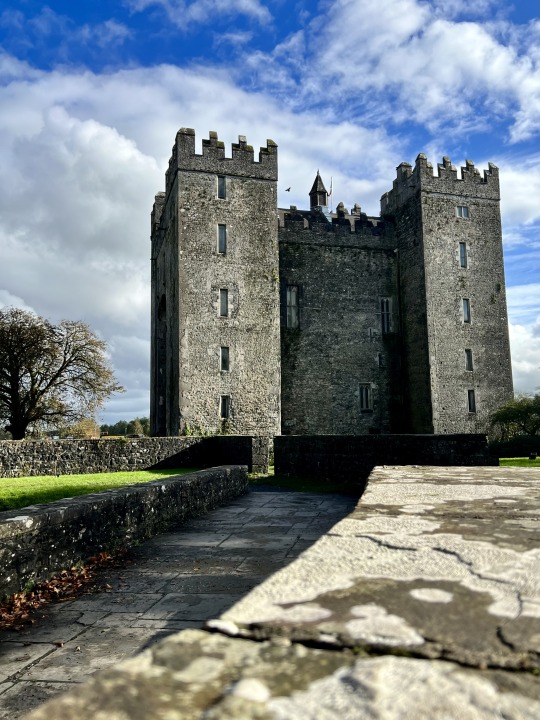
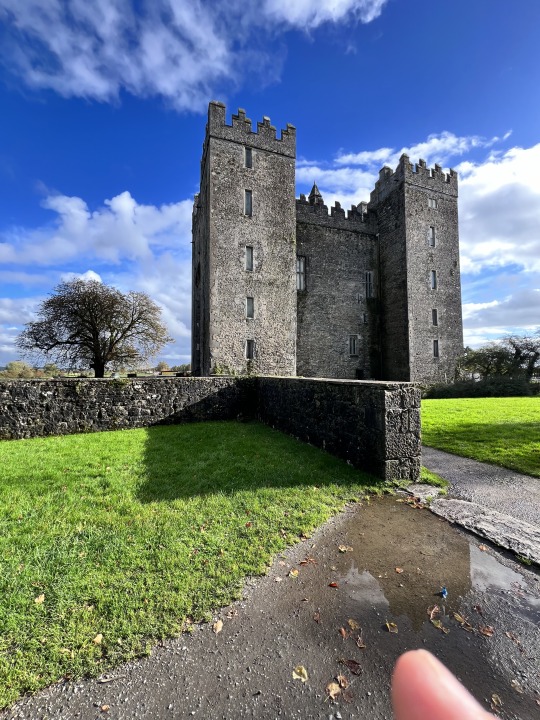
Our next stop was Bunratty Castle in - yes - Bunratty. It is a 15th century castle, the most complete and authentic castle in Ireland (so they claim). It is full of marvelous 15th and 16th Century hand carved furnishings and tapestries. The stairs were treacherous and too numerous to count. (Mom - this was not for you!). We risked our lives and went to the parapet and enjoyed vistas of the surrounding area - as the sun came out and warmed the air. The dining table is 25 feet long, and everywhere you look there is something unique, priceless, or intriguing.
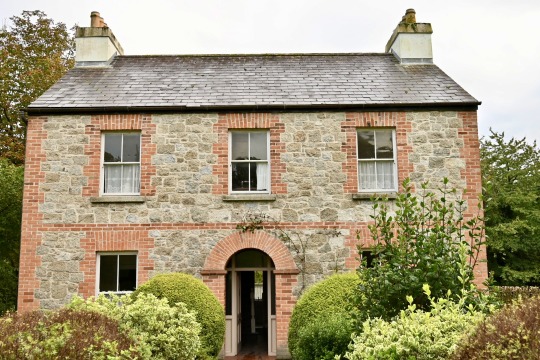
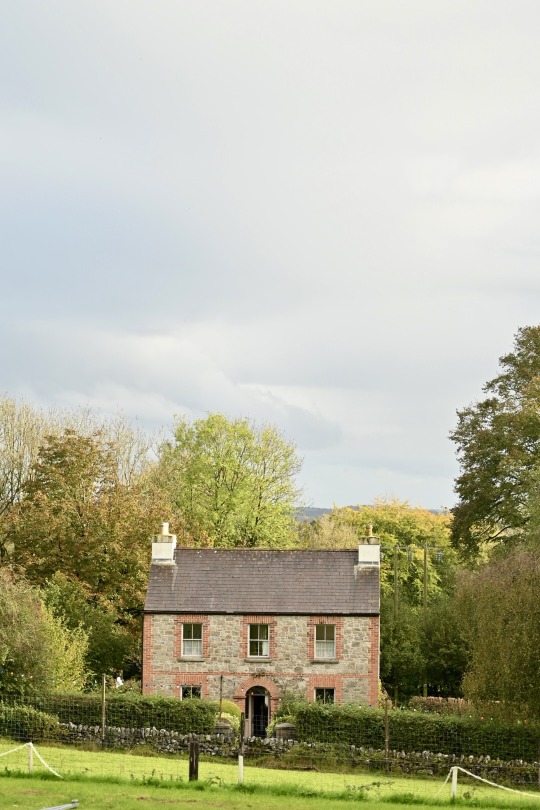
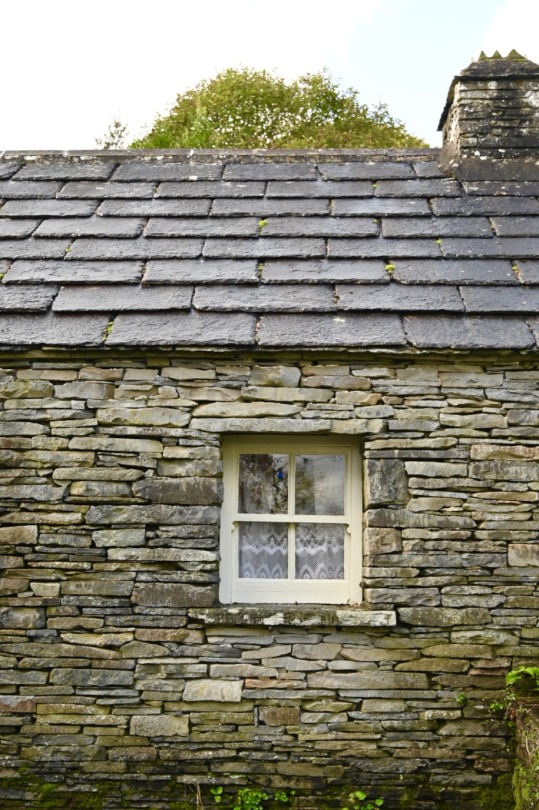
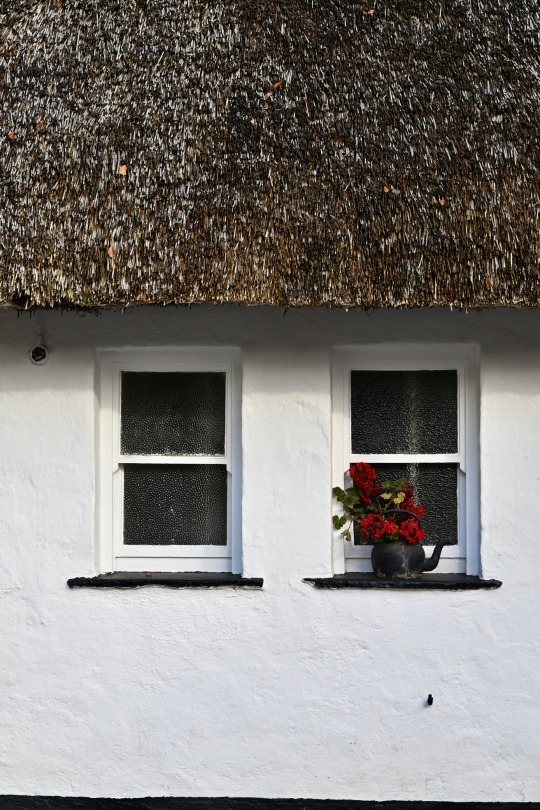
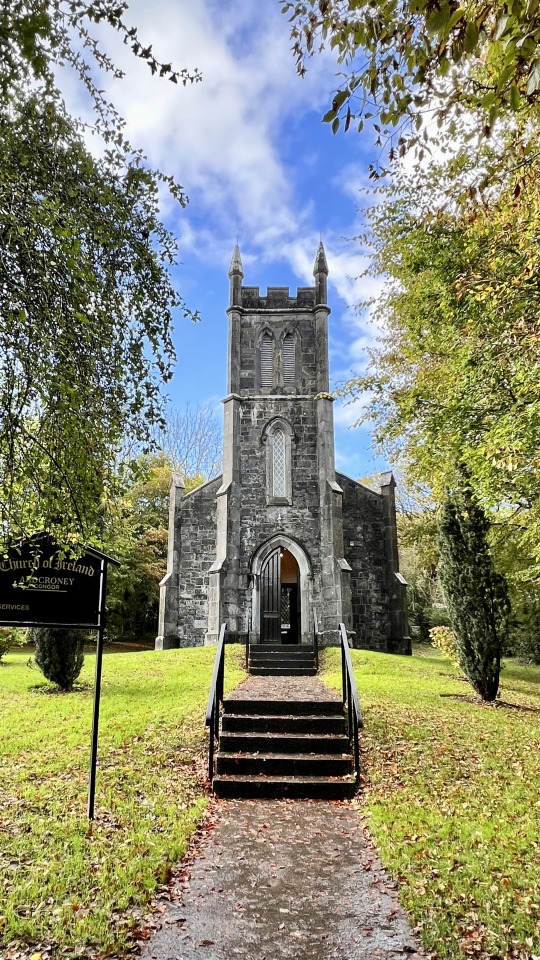
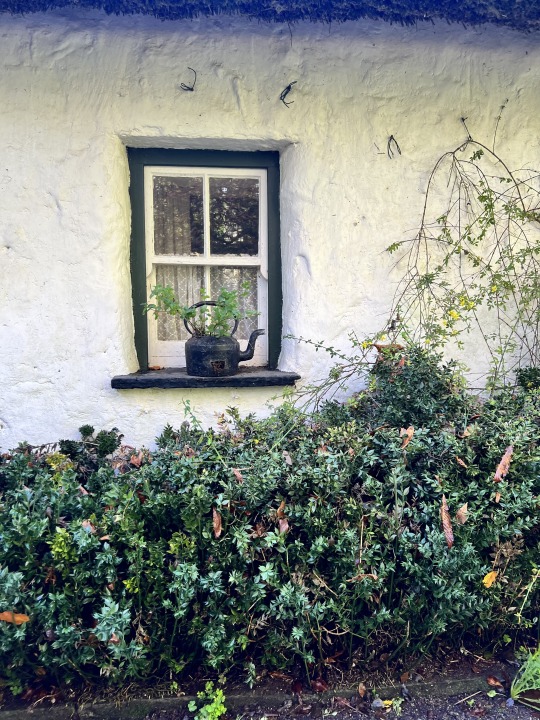
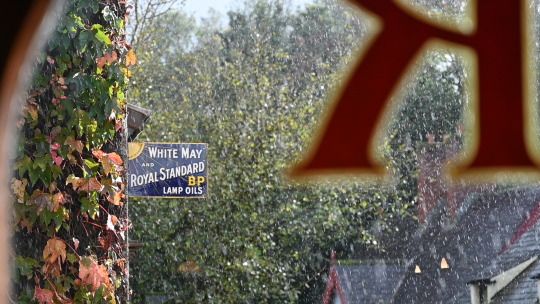
On the same property as the castle is the Bunratty Folk Park with over 30 buildings in a ‘living’ village (real wood in real fireplaces) and rural setting (real donkeys, pigs, highland cattle, and more).
We enjoyed poking around farmhouses, village shops and recreated streets. Each house is furnished as it would have appeared at that time according to their social standing, from the poorest one roomed dwelling to Bunratty House a beautiful example of a Georgian residence built 1804 home of the Studdarts, the last family to occupy Bunratty Castle. It was sunny, and then it rained, then sunny again. If you ‘don’t like the weather in Ireland, don’t worry - it changes every 15 minutes. What a wonderful afternoon. My feet are sore, but eyes have seen so much, and we both need a bathroom - so on to our bed and breakfast for the night - just 4 minutes away.
0 notes
Text


the thing is tho, An Gorta Mór never had to happen. It was not as if all the crops failed due to weather or anything like that. *only* the potato crop failed due to a potato specific disease, which would have been fine if the irish people were allowed to subsist on their other crops. but they weren't. it was all exported out by the British.
The export of livestock to Britain (with the exception of pigs) also increased during the Famine. Whilst the export of pigs decreased, the export of bacon and ham increased from 930 cwt. in 1846 to 1,061 cwt. in 1847. In total over three million live animals were exported between 1846-50, more than the number of people who emigrated during the Famine years. In 1847, 9,992 calves were exported from Ireland to Britain, which represented a thirty-three per cent increase on exports on the previous year. Some of these cattle were then re-exported to Europe. Overall, during the Famine years, food exports to Europe from Britain increased. Irish food exports, however, went much further afield than Britain or even Europe. In the summer of 1847, a New York newspaper noted that imports of grain from Ireland were even larger than usual. A wide variety of other foodstuffs left Ireland apart from livestock—vegetables and pulses (particularly peas, beans and onions), dairy products, fish (especially salmon, oysters and herrings) and even rabbits. In February 1847, 377 boxes of ‘fish and eggs’ and 383 boxes of fish were imported into Bristol alone. The butter export trade was particularly buoyant. In the first week of 1847, for example, 4,455 firkins of butter (a firkin equals nine gallons) were exported from Ireland to Liverpool. In the following week, this had risen to 4,691 firkins. Large quantities of butter were exported from Cork to all parts of Britain. For example, in the first nine months of 1847, 56,557 firkins of butter were exported to Bristol and 34,852 firkins to Liverpool. During the same period, 3,435 poultry were exported to Liverpool and 2,375 to Bristol.
@napster-insomniac
@ileolai nobody said the famine was inevitable
-
the sociopath i was responding to literally said that.
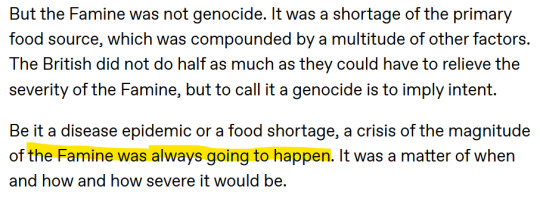
11 notes
·
View notes
Text
gods of my lineage
Irish Celtic
Name
Pronunciation
of
Symbols
Lugh
Lúg
Warrior, craftsman, savior
Sun, storms, raven, lynx, spear
Brigid
Bri-guhd
Wisdom, poetry, healing , protection
Fire, oak, 3 circles, serpent, crescents back to back
Aengus
Ang-guhs
Youth, beauty, love
Cat, dove, dove/sparror, deer, pink , red, green
Macha
Ma-chuh
War, life and death
Red, acords, crow
Goibniu
Gō-ē-nú
Smithing and hospitality
Sword, hammer, lance head, beer
Ogma
Og-muh
eloquence, inspiration, language, magic, music, physical strength, poets, writers
Chains, vines
Lir
Lər
Sea
Personification of the sea
Badb
Ba-th or baðβ]
War
Banshee, crows
Bodb Derg
Bod Dərg
Red Crow
Red, crows
Balor
Bā-lor
Giants and the scorching sun
giants
Caer Ibormeith
Kī-ər i-vuhr
sleep and dreams
Whites, swan, yew
Fódla
Fó-luh
Triple goddess of ireland
giants
Bres
Bres
Tryant god of fertility
beauty
Ériu
Érū
Modern goddess of ireland
Earth, soil, land of abundance
Neit
Nēt
War and battle
Arrows and shield
Banba
Bon-ba
Triple goddess of ireland
Protection and soil
Cailleach
Calliagh
disease and plague
Winter and blue
Manannán mac Lir
Mananán moc Lər
Sea and oceans
white water, green or a stylized fish.
Danu
Danū
Nature
stones, horses, seagulls, fish, amber, gold, flowing water, air, wind, earth, moon, keys and crowns.
Dagda
Dag-duh
fertility, agriculture, manliness and strength, as well as magic, druidry and wisdom
Pigs, harp, staff, cauldron
Morrigan
Mor-ēgan
death and fate
crow, the badb.
Cernunnos
Sr-nuh-nōs
nature, grain, wealth, and horned animals
a stag and the ram-horned serpent, bulls, dogs & rats
Dian Cecht
Dīan Sect
healing and medicine
Oak and Mistletoe
Áine
ónyuh
crops and cattle
Moon, silver & white items and meadowsweet
Belenus
Bel-enus
healing
Light and sun
Nemain
Nèmān
Triple goddess of ireland
havoc
Arianrhod
Arēan-dōd
beauty, fertility, and reincarnation
silver wheel (spinning tools i.e. shuttle, yarn
Boann
Bō-an
the River Byone
A white cow, Hazelnuts, salmon
12 notes
·
View notes
Text
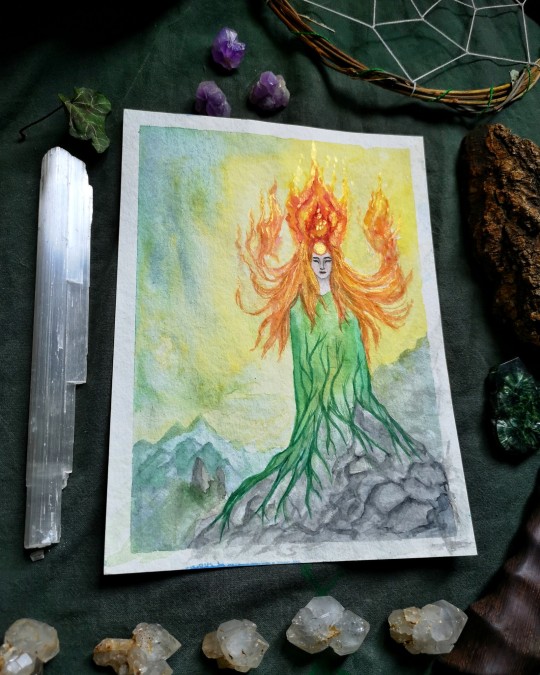
Brigid 🔥
Brigid is the Daughter of the Dagda, one of the more universal deities of the pagan Gaelic world. She is known as the Goddess of Healers, Poets, Smiths, Childbirth and Inspiration; Goddess of Fire and Hearth and a patron of warfare or Briga. Her soldiers were called Brigands. Her name means "Exalted One." She is also known as Brigantia, Brid, Bride, Briginda, Brigdu, and Brigit. She is said to lean over every cradle. The lore and customs have continued to this day regarding Brighid, more vividly than all the other Gaelic deities combined.
In the middle ages, Brigid is in many stories. In one she is the wife of Bres, the half-Fomorian ruler of the Tuatha Dé Danann. Their son, Ruadan, wounded the smith god Giobhniu at the second battle of Magh Tuireadh but he himself was slain in the combat. Brigid then went to the battlefield to mourn her son. This was said to be the first caoine (keening), or lament, heard in Ireland. Until recent time, it was a tradition to hire women to caoine at every graveside. In another story, Brighid was the wife of Tuireann and had three sons: Brian, Iuchar and Ircharba. In the tale, The Sons of Tuirean, these three killed the god Cian, father of Lugh Lámhfhada when he was in the form of a pig.
She was transformed by the Church of St. Brigid into St. Brigid about 453 C.E. Saint Brighid is known as the patroness of farm work and cattle, and protector of the household from fire and calamity. To this day, one of her most common names in Gaelic is Muime Chriosd, "Foster-Mother of Christ." St. Brigid was said to be the daughter of Dubthach, a Druid who brought her from Ireland to be raised on the Isle of Iona, sometimes called "The Druid's Isle."
#art#shamanism#witchcraft#spirit#earthborn#pagan#brigid#faery#crystal#Faeries#Fae#Faerie#Illustration#Watercolor
28 notes
·
View notes
Text
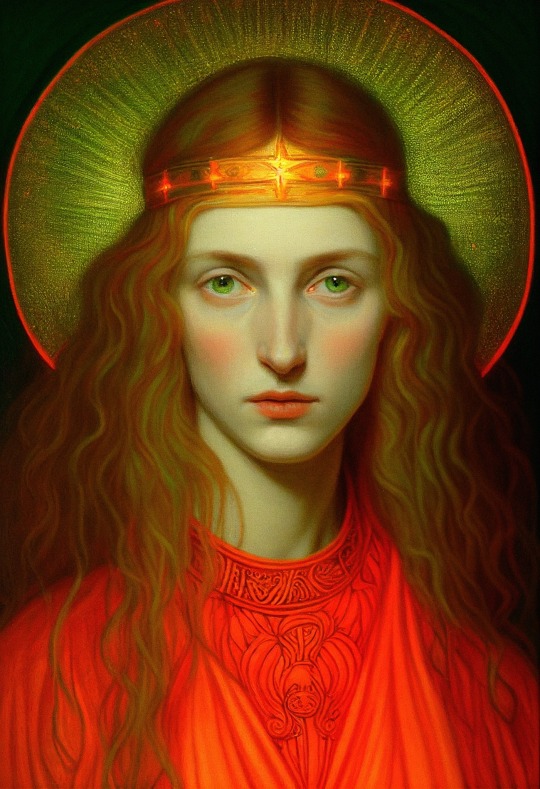
Bridget, Bright Goddess of the Gael Talon Abraxas
Brigid was a goddess of the Tuatha Dé Danann. She was a daughter of the chief of the gods, The Dagda, and was known as a goddess of healers, poets, smiths, childbirth and inspiration. Her name means "exalted one". This article by Branfionn NicGrioghair explores the story of Brigid and the later Christian Saint, St. Brigid, who is still honoured to this day, especially in Faughart, her birthplace, and Kildare, where she founded a monastery.
Brigid is the Daughter of the Dagda, one of the more universal deities of the pagan Gaelic world. She is known as the Goddess of Healers, Poets, Smiths, Childbirth and Inspiration; Goddess of Fire and Hearth and a patron of warfare or Briga. Her soldiers were called Brigands. Her name means "Exalted One." She is also known as Brigantia, Brid, Bride, Briginda, Brigdu, and Brigit. She is said to lean over every cradle. The lore and customs have continued to this day regarding Brighid, more vividly than all the other Gaelic deities combined.
In the middle ages, Brigid is in many stories. In one she is the wife of Bres, the half-Fomorian ruler of the Tuatha Dé Danann. Their son, Ruadan, wounded the smith god Giobhniu at the second battle of Magh Tuireadh but he himself was slain in the combat. Brigid then went to the battlefield to mourn her son. This was said to be the first caoine (keening), or lament, heard in Ireland. Until recent time, it was a tradition to hire women to caoine at every graveside. In another story, Brighid was the wife of Tuireann and had three sons: Brian, Iuchar and Ircharba. In the tale, The Sons of Tuirean, these three killed the god Cian, father of Lugh Lámhfhada when he was in the form of a pig.
She was transformed by the Church of St. Brigid into St. Brigid about 453 C.E. Saint Brighid is known as the patroness of farm work and cattle, and protector of the household from fire and calamity. To this day, one of her most common names in Gaelic is Muime Chriosd, "Foster-Mother of Christ." St. Brigid was said to be the daughter of Dubthach, a Druid who brought her from Ireland to be raised on the Isle of Iona, sometimes called "The Druid's Isle." -By Branfionn NicGrioghair
30 notes
·
View notes
Text
Life During The Viking Age
Majority of the Vikings used to work as farmers for their living. They were used to growing crops like oats, barley and rye and reared goats, cattle, pigs, chickens, sheep and horses. In many areas of Scandinavia, most of the people resided in timber houses. However, some built their own with stone or turf in areas where wood was limited. Some of the Vikings even worked as fishermen. They used to catch sea fish, freshwater fish and even hunted whales. Salt was an essential product and was mostly bought from travelling traders. They used to preserve meat and fish to eat during times of limited food supplies and the long winters.
VIKING WOMEN AND CHILDREN: In the Viking society, depending on their social standing, women had little power because it was a male-dominated society. It was their women who took care of all the men’s jobs and their own too whenever their men were away for fishing, raiding, exploring or if they would be on some trading mission. Because of the amount of value a woman held, it was considered to be shameful for any man to hurt a woman.
ROLE OF WOMEN: The Viking Women had a very domestic role. They used to look after their families, do the laundry, prepare food, milk the animals, make cheese and butter, preserve the food for harsh seasons, cleaning, gardening, and the task that took most of their time was to make their family’s clothes. They would spend as many as 35 hours in spinning, weaving, carding, cutting and sewing the clothes.
Viking women used to get married at young ages of about the age of 12 which were usually arranged by the parents of them both. Their marriages were more like deals between the two families. A bride price was paid to the bride’s family by the groom’s family once the couple was engaged. At the time of marriage, the bride’s father paid with a dowry.
VIKING CHILDREN: The Viking children were not enrolled to schools. Instead, the boys were educated by their fathers, brothers and uncles about all of men’s work. Girls used to work with their aunts and mothers and learned cooking, gardening, taking care of domestic animals and making clothes.
However, there usually were exceptions to such social rules of behavior. For instance, when men went to settle in Iceland, Vinland and Greenland, the women used to go with them. Vikings used to settle in Ireland, England and France as families. But, only men went for trading and attacking when women stayed at home and took care of the farm.
At that time, as compared to the other European women, the Viking women used to have more power. They had the power to divorce husbands, own property and even sell their handicrafts. Some women even became wealthy landowners or even participated in trade.
BOTTOM-LINE: The Age of the Vikings ended as soon as the attacks stopped. The best marker for the end of their era is the year 1066. It was the Battle of Stamford Bridge where the Norwegian king called Haraldr harðráði was revolted and killed since he tried to regain a part of England.
Know more about Vikings Pride and it's Viking Jewelry For Sale. Visit our website https://vikingspride.com/
2 notes
·
View notes
Text
Biden Should Acknowledge Irish Genocide
LOS ANGELES (OnlineColumnist.com), April 25, 2021.--President Joe Biden, 78, declared yesterday that the United States officially recognizes the Armenian genocide at the hands of the Ottoman Turks [1915-1917] where some 1.5 Armenians were massacred or marched into the Syrian dessert where they perished from starvation and exhaustion. Turkey’s 67-year-old President Recep Tayyip Erdogan condemned Biden’s declaration, long over due when you consider the “genocide” took place 106 years ago. Biden has raised the flag of human rights to push U.S. foreign policy, putting all nations on notice that the U.S. is the beacon of hope for human rights around the planet. When Biden visits the U.K. June 11-13, he plans to make the short trip to Dublin where he should say the U.S. recognizes the British genocide of the Irish in the so-called Potato Famine [1845-1852] where at least 1 million Irish perished from starvation.
Ireland had a robust population of 8.5 million at the beginning of the famine but by the time the famine ended in 1852, the population was ravaged, cut to 4.5 million , currently at 4.9 mlllion. But like the American Indians during Colonial Days, it’s difficult for the U.S. census bureau to account what happened to the 15 million native population in Colonial Times. Today’s native population stands at 5.22 million, accounting for missing gaps in U.S. history. When you read most U.S. history books, native Americans died off on their own. In Howard Zinn’s 1980 “Peoples History of the United State,” he tells a different story of what happened to the U.S. Native Americans, namely, a U.S. government genocide. When its comes to the Irish, Tim Patrick Coogan’s 2012 book, “The Famine Plot,” makes a compelling case for how the British, dating back to the days of Oliver Cromwell, committed genocide on Irish.
Unlike the U.S. with the Native Americans, Coogan goes into exhaustive historical detail about how the British capitalize on the so-called Potato Famine to eradicate the Irish, viewed in British history as “sub-humans” compared to the British. When President Andrew Jackson signed the Indian Removal Act May 28, 1830, the U.S. government declared open season on Native Americans, beginning the official U.S. genocide. Cromwell’s Irish campaign 1649 to 1650 was supposed to conquer Ireland, reporting in his carefully documented logs that he discovered unbridled savagery of the Irish people. Jackson referred to Native Americans as “savages,” the same language that accompanies genocide since the beginning of time. When Polish lawyer Raphel Lemkin coined the term “genocide” in 1943 observing the Nazi Holocaust, he cited the Ottoman Turks massacre as a case in point.
Lemkin needed to go back another 70 years in world history to see more clearly what the British did to finish off the Irish during the 1845-1852 Potato Famine. Coogan contends with irrefutable evidence that the Potato Famine was the excuse used by the British to exterminate the Irish, making sure that British-controlled areas of Dublin and Belfast has plenty of resources to combat the famine. In Thomas Gallaghher’s 1982 book, “Paddy’s Lament,” documents while some 400,000 Irish peasants died of starvation in the winter of 1846, British-controlled land barons exported 17 million pound sterling worth of grains, cattle, pigs, flour, eggs and poultry to the U.K. British Statesman Sir. Walter Raleigh [1554-1618], a contemporary of Cromwell, spoke disparagingly about the Irish to the British Parliament. Coogan goes into painstaking detail to identify Charles Trevelyan as caring out the Irish genocide.
Coogan, Ireland’s most prominent historian, doesn’t take his work lightly tying the British Crown and parliament to the “Famine Plot,” shipping off boatloads of Irish grown and made products to the U.K. while Ireland starved. Coogan points out that the same potato blight hit Scotland, where the British government made sure they got adequate supplies to prevent starvation. Compounding British animus toward Ireland was Henry VIII kicking out the Catholic Church 1533 from England so he could marry pregnant Anne Boleyn. Centuries of hostility with Catholic Ireland and Anglican Britain didn’t help the Potato Famine when it hit Ireland in 1845. “In the present Convention, genocide means any of the following acts committed with intent to destroy, in whole or in part, a national, ethnical, racial, or religious groups, as such,” Coogan identifies British conduct in the 1845-1852 potato famine.
Former British Prime Minister Tony Blair [Labor Party] said in 2011 he was prepared to call the main thesis of Coogan’s 2012 book, “The Famine Plot” genocide against the Irish. Blair never officially recognized the Potato Famine as “genocide.” When Biden visits Ireland in June, it will be a great act of courage for the historic record to recognize the Irish Potato Famine as genocide. What could be a better example of genocide than the British government appointing its henchman Charles Trevelyan to preside over the diabolical plot to starve the Irish population when the British were swimming in food. As Coogan points out, Scotland experienced the same potato blight but had no real problems with food shortages. “The real evil with which we have to contend is not the physical evil of the Famine but the moral evil of selfish, perverse and turbulent character of the people,” demonizing the Irish.
About the Author
John M. Curtis writes politically neutral commentary analyzing spin in national and global news. He’s editor of OnlineColumnist.com and author of Dodging The Bullet and Operation Charisma. Reply Reply All Forward
1 note
·
View note
Video
youtube
Traditional Farming Documentary -- Farm life in Ireland during the 1930s - "Preserving the Past"
This traditional farming documentary follows the farming year and way of life for the people of Ireland at the begging of the last century. Filmed in Muckross Traditional Farm, Killarney, replicas farms and dwelling from that period exist to show what life was like in rural Ireland during the 1920's and 30's. The farms themselves are actual working farms with their own horses, cattle, sheep, pigs and hens, they are situated in the centre of Killarney National Park. We show the farming methods as they would have been in this era when all farm work was carried out by horses, donkeys and human labour. Planting potatoes in ridges, growing corn (oats) and haymaking are shown in this film along with the harvesting of the crops and the threshing. We also follow the woman year on the farm showing butter and butter milk being made and bread making. A variety of different crafts and traditional Irish skills such as blacksmiths are captured in this historical documentary. Produced by Thompson Video Productions Co. Derry Northern Ireland. Please subscribe to our channel here for more farm videos. Find us online at Videos of Irish Farming Life or visit www.irishfarmingvideos.com
4 notes
·
View notes
Text
Monday 4th August 1828
4 50/60
12
In spite of sprinkling my bed with vinegar bit last night - on the box of the Independent coach at 5 55/60 - stop 5 minutes at the great coach office higher up the street (Argyll street) opposite the tower - stop at 7 ½ at the Hamilton Arms, Hamilton, for 5 minutes but do not change horses till, after passing the fine 5 arch bridge over the Clyde and Evan, stop at Wishaw at 8 20/60 -
A native of Berlin on the coach - said the best part of the scenery on the Rhine was from Cologne to Colmar - he traveled per coach not like our coaches (the German malle poste in fact) carried only 9 passengers from Berlin to Cologne 80 German leagues or 400 English miles - Accum Frederick the book leaf stealing London Chemist, has built a house at Berlin - teaches English and chemistry - Humbolt gave gratis lectures twice a week last winter before the King and such as he chose to admit - going to publish a complete set of his works - set down our Berlinois and an Englishman at Cartland Crags to go down to the stonebyres falls, and stopped at the Clydesdale Inn, Lanark, at 9 50/60 - breakfast off again at 10 ¼ - in 3 or 4 minutes, right, ruined church, old Lanark burying ground - at 10 25/60 on 1 side the road (right) wall of the fir plantation (house not seen) of Bonniton (Lady Mary Ross) on the other (left) Lanark race ground one mile round a nice looking little course - said to be good races here - good red road, made of (said the coachman (sitting on my left) left handed - the 1st left handed coachman I ever saw in my life) burnt stone - all the stone hereabouts red sandstone - fine-ish open country - thorn hedges -
The mail had turned off 6 miles before Lanark and we should get into her road (for a little way) 17 miles from Lanark - at 10 35/60 cross the Clyde, Homeford bridge handsome 5 arch red sandstone bridge - at 10 55/60 sort of moor all round, partly cultivated partly sweet gale and heather closed by the Bigger hills in the distance - at 11 35/60 change horses at Chester Hall Inn (lone house) comfortable Inn enough coach from Edinburgh meets us here - take up passengers and luggage and off at 12 - between Hamilton and Lanark bull without horns, polled, i.e of the Galloway breed - never before saw a bull of this breed - cutting hay grass beyond Chester Hall Inn - Telford did the 8 miles of new road to Lanark and surveyed the whole line [?] from Sterling to Caerlisle 110 miles - at 12 35/60 pass over Duneaton bridge 3 arches over Duneaton river good river - falls into the Clyde just below the bridge -
At 1 12/60 change horse at Crawford - neat white Inn neat small church straw thatched partly blue-slated village - the ruin of Carwford castle (belonging to the Colebrooke family) just on the other side the Clyde (still a goodish river) neither large nor picturesque as seen from the village - more like the ruin of an old gable under house than a regular castle - a few old shabby trees around it and ? at a little distance a neatish white farm house nearly hid among the old trees and farm buildings - at Crawford (thro which the mail passes) the mail-road distance from Glasgow to Caerlisle is marked Glasgow 40, Caerlisle 54 = 94 miles; but the distance we go (vide itinerary) is about 119 miles - on asking the coachman why we did not as I had understood at Glasgow we should, pass thro’ Kilmarnock (22 miles from Glasgow) he merely said the coach did not go that way today - No Beauty in the vale of Clyde from Chester Hall Inn to here (Crawford) bleak, bare hills, goodish sheep-pasture and not very good land bottom - no wood - the hills nearer Crawford and beyond brown heathery wildish and bare a peat moss just on getting out of the village - no orchards all the way from Lanark neither did I see any about Hamilton - why Clydsdale the orchard of Scotland - no part left for it but the 14 ½ miles (charged 15 miles) from Lanark to Hamilton and in the 1st 2 miles from L-[anark] only saw to little orchards when there before -
Off from Crawford at 1 20/60 - at 1 35/60 2 roads that to the left, the mail road to Carlisle - we take that to the right, to Dumfries and pass over 1 arch stone bridge over broadish stream which most at a very short distance fall into the Clyde below - the village of Leadhills or 5 miles from where the 2 roads meet - Leadhills lies between us and Sanguhar (pronounced Sankar) Clyde close left, and handsome 3 arch bridge and Newton, Lord Newton, a good, comfortable-looking square, 3 story, red sandstone house (like an English shooting box) and small village of Ellwell foot consisting of ½ dozen straw thatched cottages and a white Inn - we had had rain but not much, from 11 20/60 from ¼ hour but it began to rain about 1 ¾ and rained very heavily for about an hour, however I was not much wet, I have my tartan cloak which was soaked thru’ wild, bleak, bare road (on the ascent) till about 2 ¾ when we reach the head of the glen of Dalveen where began the property of the Duke of Bucleugh - here too changes the course the waters which on the other side ran towards the glen the German ocean and here ran towards the Atlantic - the Curron run down along the glen - the lofty precipitous green mountains occasionally stripped with shingle, the narrow green glen with its little rapid stream (the Carron), the road gradually descending along the mountain side (made about 14 year ago) fenced off like the Simplon with set stones at 2 or 3 yards distance, the steep height above and the steep depth below, very fine - luckily the rain was rather abating and I could hold aside the umbrella to look about me - not expecting the fine glen perhaps it struck me more - in 10 minutes down the little white one-story Inn and turnpike (lone house) - change horses in 5 minutes and off again at 4 (peats here) in 5 minutes more turn left with the Carron and out of the glen of Dalveen [?] and enter wide bare-hilled valley along the bottom of which the Carron flows down a little shallow glen (as it were within the wider glen) unpicturesque because no wood till a mile or 2 from Drumlaurie castle (duke of Buchleugh) here we get pretty will wooded - a few gentle seats all along here and there from Glasgow but not in general conspicuous enough for me, on the top of a coach to note them down - Drumlanrick castle distance right , old house-like castle conspicuous among woods -
At 3 ¾ island in 2 or 3 minutes more pass thru’ the neat little village of Cornbrig or Thornbrig? (Slates or rather flags put on diamond-wise here and afterwards, because in the common way they will not drain each other so well) wildish, wide country bounded all by ranges of hill - pretty well wooded southwards - red sandstone fence walls and but few thorn hedges here and ever since leaving Dalveen - at 4 change horses at the very good village or nice neat little town (houses chiefly 1 story high) of Thornhill - old fluted column with sort of fret-work capital surmounted by a diminutive looking flying horse - stands on a high, large base a pedestal (hexagon?) 3 steps running all round it - called the market cross - red sandstone town, but mostly washed over and generally white -
Off at 4 10/60 - open habitable, green more populated country - peat moss just below the town - at 4 ¾ come down up the Neth, board good river - (the flat banks seem rather wooded and pretty) pass the 3 brothers (a fine large green oak of 3 exactly similar boles from 1 stock) and at 4 51/60 cross handsome, 3 arch, red sandstone bridge (Algirth bridge) over the Neth, and change horses at 4 55/60 at a mere cottage and little stable 8 miles from Dumfries - at 5 ¼ (little distance left) almost hid among the trees, Ellisland (6 miles from Dumfries) as (as pronounced) the farm occupied by the poet Robert Burns - the house and farmstead still as when he left it - at 5 35/60 see (left) in the distance beyond us peeping from among the trees, the ruins of what the coachman calls the Old College of Dumfries - Cross and Clooton (as pronounced) over 1 large arched red sand stone bridge and pass thro’ the small village of Clooton - prettyish or fineish drive from our 1st coming down upon the Neth to Dumfreis and goodish land 3 or 4 miles from Dumfries - Cross fine 7 arch red sandstone bridge (an older red sand stone bridge of 7 arches at a little distance right also over the Neth) over the Neth (fine river here) and enter Dumfries, and stop at the Kings arms at 6 - very civil people and could have staid there comfortably seems a good inn - excellent hodge podge and some hot roast beef and a little baked pudding but hardly time to eat - dined in 12 minutes - had been quarter hour upstairs changing the paper of my napkin much of my cousin -
Nothing to see in the town, but Burns’ monument in the old church yard - 3 churches (all and town too red sandstone) with neat spires - very nice, neat, pretty town - no trade - depends on its cattle market - great market for pigs from Ireland - Thorn hedges and fertile all (off from Dumfries at 6 ½) round the town - save where the large peat moss just out of the town, and now so accustomed to this can scarce think the comforts of a Scottish town secure with a peat moss - capital road - white villages and houses scattered all around - very few horned cattle - the polled all here abouts i.e the Galloway breed - asked if they were good milk cows, yes! but excellent beef - at 6 55/60 1st turnpike from Dumfries - 2 roads - left 16 miles to Annan - hilly - the mail road - could go the other in as little time, but several gentleman’s seats that way, and ‘it suits’ to have a church on each road - right, our road, 17 miles but pay only ½ toll that way - from here the country plain, flat, not wooded - nor pretty neither picturesque -
At 7 10/60 see the Solway Firth and 2 stooks of oats cut - had ask before why so corn was so much forwarded than the rest, particularly 1 patch of oats quite yellow,and another close to it quite dark green - ‘Oh! because the land’ (of the yellow oats) ‘was lighter’ - at 7 35/60 change horses at the end of the little white village of Clarensfield (as pronounced) - Pass close under the very neat good and small white row of houses called Cumertree and at 8 ½ cross 3 arch red sandstone bridge over the river Annan and enter the good red sandstone but pretty white washed, town of Annan - handsome church steeple - the towns always better as nearer England small coal smoke here - off at 8 40/60 - getting too dusky to see much - disappointed that we do not pass thro’ the village of Gretna Green but change horses at 9½ at a little white Inn by the road side ¼ or ½ mile from the village - the mail changes at the Inn (excellent built by Col. Maxwell to whom Gretna belongs for himself but his wife did not like it so let it for an Inn and it is one of the best on the road) in the village -
At 9 50/60 at the last turnpike in Scotland - the girl gave the coachman whisky - 4/. per gallon duty on it in England, and not drinkable there - so tasted with the coachman by way of adieu to Scotland and her whiskey, thou’ I had been all along the road musing whether to go from Carlisle to Selkirk (6 miles from Melrose Abbey and 60 miles from C-[aerlisle] according to the coachman) per mail which leaves C-[aerlisle] every morning at 7 for Edinburgh - I ought to have gone from Glasgow to Edinburgh and thence by Selkirk, but feared time and knew not exactly the mail-road - almost immediately after leaving the last turnpike cross bridge over the Sark another great stream that here parts England from Scotland - soon afterwards pass the cast iron bridge (one of the 1st of these bridges) over the broad Eske - the tide comes up as far as here - tis called the head of the Solway Firth said our coachman -
Heavyish rain for about 20 minutes before getting into Carlisle - alight at the blank space a second rate sort of not very comfortable coach house at 10 50/60 - by the negligence of the guard my box (caravan) of light things taken off and left at Dumfries - to have at 5 p.m. tomorrow - so I must stay here whether I would or not - about 1 ¼ hours heavy rain early in the afternoon (vide above) but very fine evening from about 5 to 10 ½ and fine morning till it began to look threatening about 11 -
[Left margin: about ¼ hour or perhaps 20 minutes passing the glen of Dalveen - maybe about 2 miles long of fin[?] [?] perhaps a mile of the very fine? the Carron falls into the Neth]
(Diary reference: SH7MLE110041 & SH7MLE110042)
3 notes
·
View notes